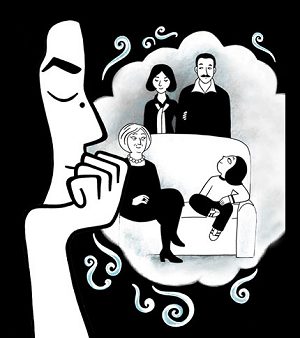Serendip is an independent site partnering with faculty at multiple colleges and universities around the world. Happy exploring!
Notes Towards Day 12 (Thurs, Feb. 23): Growing Up Graphic

I. Coursekeeping
final name tests?
reminder of particular posting expected Sunday evening,
to begin co-designing the last 9 classes of the semester
no reading next week
so review what you know/have read...
and read some of what you feel you might have been missing;
for ex, see some of the (recommended....) work in genre theory:
Carolyn R. Miller and Victoria Gallagher,
"Emerging Genres" (a Workshop for the Rhetoric Society of America)
Miller's "Genre as Social Action," Quarterly Journal of Speech 70 (1984): 151-167:
as recurrent patterns of language use,
genres help constitute the substance of our cultural life.
A genre is a rhetorical means for mediating private intentions and social
exigence; it motivates by connecting the private with the public,
the singular with the recurrent....
The perspective on genres proposed here has implications not only for criticism
and theory, but also for rhetorical education. It suggests that what we learn when we
learn a genre is not just a pattern of forms or even a method of achieving our own
ends. We learn, more importantly, what ends we may have: we learn that we may
eulogize, apologize, recommend one person to another, instruct customers on behalf
of a manufacturer, take on an official role, account for progress in achieving goals.
We learn to understand better the situations in which we find ourselves and the
potentials for failure and success in acting together. As a recurrent, significant action,
a genre embodies an aspect of cultural rationality. For the critic, genres can serve
both as an index to cultural patterns and as tools for exploring the achievements of
particular speakers and writers; for the student, genres serve as keys to understanding
how to participate in the actions of a community.
Anne Freadman, “Anyone for Tennis?," Genre and the New Rhetoric, ed. Aviva
Freedman and Peter Medway (Bristol, Pa: Taylor & Francis, 1994), pp. 43-66.
Anyone for tennis? as a catchphrase typifies the kind of drawing-room comedies
in which someone stepped in through the French windows, lightly swinging a racket
...and breaks up the formal scene: understanding genre is understanding
the way a text "plays": its tactics, strategies, ceremonial place;
learning to write is learning "to ensure a useful uptake";
learning to read is learning “how to take it up”
(what's that mean?
keeps the ball in play, or makes the “score”?
(certifying expertise/which stops the game?)
the value of Freedman's very elaborate metaphor, of tennis
(or: how "game" corresponds with "genre"): is that it puts
individual action in relation to regulative rules/
ceremonies: rules for setting the game,
knowing how much "play" the rules allow
genre is pragmatic, tactically useful, w/ an etiquette
understand rules of genre=know when/
where appropriate to do/say certain things
one of the tasks of a text: mark itself generically,
to get its partners to "play ball" appropriately
don't separate form, content: game constituted by its rules
What none of these classic analytic texts does
is talk about how genre gets transformed:
--by the strength of one example?
--by a certain # of innovations?
--is there a tipping point?
--what’s the process for revising the e/valuation of a new genre?
We are looking @ that, as we figure out how Persepolis "works"....
II. On Tuesday, we began to discuss the visual/
graphic dimensions of Satrapi's work.
The best essay I know of, on this topic, is Hilary Chute's
"The Texture of Retracing in Marjane Satrapi's Persepolis."
Women's Studies Quarterly 36, 1&2 (Spring/Summer 2008), 92-110:
Satrapi's stark style is monochromatic --
there is no evident shading technique;
she offers flat black and white ....
"the depiction of deliberately empty spaces" ...
frequent scenes in which public skirmishes appear as
stylized and even symmetrical formations of bodies ...
to present events with a pointed degree of abstraction
in order to call attention to the horror of history ...
a flatness of composition to intensify affective content
"I cannot take the idea of a man cut into pieces and just write it.
It would not be anything but cynical. That's why I drew it"
... from a child's ... perspective ....
child's eye rendition of trauma ...
haunts the text because of its incommmensurablity
... the author draws a scene of death... as a child imagines it ....
in a form keyed to structural gaps through the frame-gutter sequence...
... no perspective, however informed, can fully represent trauma ....
it is in "excess of our frames of reference" .... [In] a child's imaging of torture ...
one recognizes not only the inadequacy of any representation to such traumatic history,
but also ... the simultaneous power of the radically inadequate (the child's naive confusion).
Persepolis shows trauma as ordinary, both in the text's form -- the understated, spatial
correspondences Persepolis employs to narrative effect through comics panelization --
and in style: the understated quality of Satrapi's line that rejects the visually laborious ...
to departicularize the singular witnessing ... to open out the text ... while Persepolis
may show trauma as (unfortunately) ordinary, it rejects the idea that it is
(or should ever be) normal ....
Persepolis offers not simply a "visibility politics,"
but an ethical and troubling visual aesthetics...
more exs:
'The Heroes' (esp. p. 52);
'The Cigarette' (esp. p. 117), and
the abstract visuals on pp. 77 and 89.
Others that you brought in for discussion....?
froggies315: At the end of class today, we started talking about
what Statrapi’s comics mean .... These types of conversations are
hard for me because finding meaning in art has always been difficult/
impossible for me....I don't "get" art in the way that is often expected
of me. McCloud helped me by explicitly saying ... “[Art] means what
it IS...ink on paper" ....all they actually mean is what they literally are...
What if we just read to read (!) and then, if we're moved to, reflect on
how the work has changed us?
I hate the feeling of participating in a prescribed activity. This is what
happens when I start thinking about what things mean. When we give
meaning to pictures, it makes them less real--it narrows the reactions
we can have. For me, at least, this is not good. It makes me feel trapped.
Cf. Freedman: "meaning is not content; it is place and function"
III. Within this representation of trauma, Satrapi
tells us the story of a little girl, growing up.
Today let's turn to look @ this text as a form of
"autographics"--->graphic versions of autobiographies.
On Tuesday I had asked what it means, in the history of women-as-visual object,
to create a visual text about a woman's life: What is the effect?
And now I'll ask: what role do the words play in this graphic narrative?

Hilary Chute (continued): Some of today's most riveting
feminist cultural production is in the form of accessible
yet edgy graphic narratives....."graphic narratives"...
destabilize standard narratives of history .... bridging
wartime-focused testimonies and child-oriented testimonies
...Persepolis is about the ethical verbal and visual practice
of "not forgetting" ... modeling a feminist methodology
in its form, in the complex visual dimension of its
author narrating herself on the page as a multiple subject.
Let's spend some time today sharing our sense of who Marjane is.
Find another page (or 2) with an interesting intersection of text-and-image.
How "individual"/how "doubled"/coherent/fragmented is Marjane in this form?
What's the difference between what she SAYS and how she is SEEN?
What can we see of her internal life?
IV. What do we think of autobiography as a feminist genre?
Absolutely: "representing the voices of the unrepresented"?
Or absolutely not: in its focus on the individual self?
What is the role of the collective, the larger whole?
Or of other small parts? Or: who lacks voice or vision here?
Who is not represented, when the self represents itself?
Nancy K. Miller, "The Entangled Self: Genre Bondage
in the Age of the Memoir." PMLA 122, 2 (2008): 537-548.
"Memoirs from sites of danger provide a safe space for
readers to ponder the nightmare of contemporary global
relations, even as the pages display the extreme difficulty of
living in times of traumatic history. The story of the other citizen,
preferably female--the exotic, foreign self in translation
(like us after all)--is also a valuable template in the marketplace
of contemporary autobiographical production and consumption."
the female autobiographical self ... goes public with private
feelings through a significant relation to an other .... the other
provides the authorizing conditions for self production ....
"Isolate individualism is an illusion" .... Autobiography's
story is about the web of entanglement in which we find ourselves .....
The reader ... is the autobiographer's most necessary other ....
You conjure the reader to prove that you are alive ....

V. But there are very different worlds of
women in the Middle East , "not like us after all."
Where are the literary texts that represent them?
Can literary feminism be feminism,
if it depends on written representation?
And most of the world's women can't read or write?
How to represent those who cannot represent themselves?
(who are not trained in art school, as Satrapi was?)
Spivak's "Can the Subaltern Speak?"
(a founding text of postcolonial studies) focuses on
suttee, the religious practice (banned by the British in 1829),
in which a recent widow would immolate herself on her
husband's funeral pyre. Spivak points out that all accounts
of what suttee meant to (or how it oppressed) women
are re-presentations (by British colonizers or Hindu leaders),
but there are no records by the suttee-performing brown women
themselves: "the subaltern cannot speak."
Anat Berko, Path to Paradise: The Inner World of Suicide Bombers and Their Dispatchers (2009):
an Israeli researcher who tried "to open a window for the reader
into the inner world of men and women who blow themselves up" -->
"Western society, for which human life is the supreme value, finds it
difficult to define and understand the suicide bomber's behavior" (p. 12)
"Now we're just passing through. Real life is in paradise...
in fact he isn't dead, he's in paradise and he's still alive" (p. 159)
"For the suicide bombers, such dreams [of paradise] are a concrete reality" (p. 171)
"It's more impressive when a woman carries out a suicide bombing attack,
because this is the Middle East and a woman is very limited,
and that makes her action special" (p. 112)
"female suicide bombers...were the expression of a unique wave of feminism,
which allowed them to improve their social status" (p. 114) 



